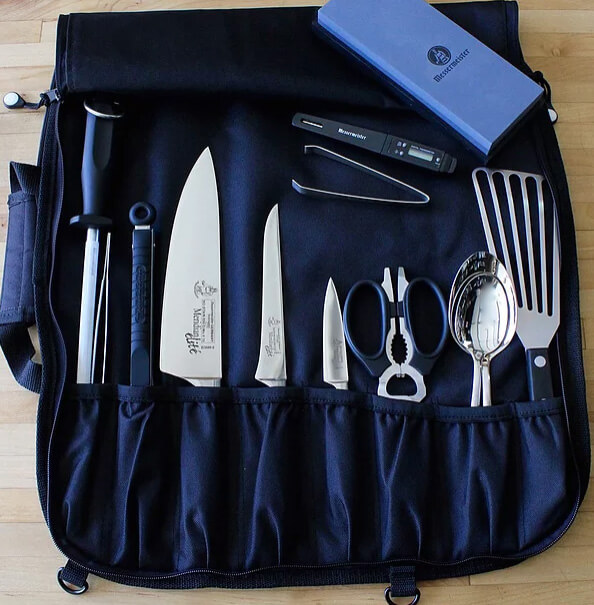Choosing Maintaining and Sharpening Kitchen Knives

Choosing Kitchen Knives
We received a question recently about sharpening knives and thought this would be a good time to address some points on knife construction, materials, maintenance…and the one that most people are not sure of so they just skip it…sharpening! No matter what knife you have bought on TV that will cut through a brick and then a tomato, there is no way possible that you can own a quality knife without having to maintain and sharpen it. I will address how the brick/tomato knife thing works later on, but for now you have got to trust that there is not a quality knife in existence that will perform well in the kitchen and require no maintenance or sharpening.
When you think of a chef, what are some of the tools of the trade you think of? A knife is likely the first thing on your mind. A cop needs a gun, a construction worker needs a hammer, a doctor needs a stethoscope, a samurai needs his sword. Yes, you can cook with a horrible rusted piece of junk…but you can’t cook well. Proper knife work is really important to good cooking technique. For instance, if you take a carrot and cut some of it in ¼ inch pieces, some in ½ in pieces and some in 1/8 in chunks, and cook all the pieces up, what will be the result? If you throw all of these uneven pieces of carrot into a pan and summon all your Jedi Knight cooking Forces to cook them all perfectly, will it happen? Well, let’s fast forward to what would happen. The small ones will be done but the big ones will still be rock hard. Now, if you keep cooking, the big ones would be perfect but the small ones would need the last rites because they have would have been cooked to death. Bottom line, everything needs to be the same size so it all cooks at the same rate. You need good knife skills. Now we can begin!
Below is a list of the topics I will be touching on during this little rant:
- Metals used for knife construction & What to look for in a good knife
- Hardened steel vs softer steel
- Japanese vs German style knives
- Maintenance schedule
- General thoughts and recommendations
Metals
Knives are going to be made of steel (except for the new ceramics on the market which are a whole other discussion, and those crazy green plastic lettuce knives). There are two major versions of steels that you will encounter, stainless and high carbon.
Stainless Steel
Stainless steel accounts for most of the knives on the current market except for some traditional Japanese blades and knives of a significant age. Stainless is almost exclusively used because it is user friendly and can be hardened to the point way past what the home cook would need. Steel is iron with carbon added. Add at least 12% Chromium to that little mix and you have created stainless.
There are levels of stainless just like anything else. Lower quality stainless is just what I have listed above, but higher quality stainless often includes elements like nickel, molybdenum, and titanium. Look for that molybdenum one as it is often in stainless used for kitchen knives.
High Carbon Steel
This is not common outside of Japan and I don’t recommend using them for the home cook.
The deal with carbon steel is that it will rust and discolor when you look at it sideways. When you wash it you would need to dry it immediately and very thoroughly.
Bottom line, they require a much greater level of maintenance past what the home cook may be willing or prepared to do. My recommendation is to go with a stainless steel knife. It will perform well for you and will be forgiving if you forget to dry it off right away or if you leave it on the counter for 10 minutes after cutting that onion. Carbon steel would be very upset with you if you did that….and hell hath no fury like a carbon steel blade scorned!
Hardened Steel vs. Non-Hardened Steel
It would sound like the harder the steel your knife was made of the better right? Wrong…sort of. When steel is hardened it becomes more brittle. If you hardened steel to the upper limits of what was possible it would eventually shatter like glass. For the kitchen most cooks want a knife that is tough enough to cut through chicken bones and chop our vegetables without breaking or putting a big divot in the edge. There is good news, most quality knives are going to fill that job description. There are plenty of knives made of a softer steel that are economical and easy to maintain that will perform very well for you. I own a few of these knives myself.
The Forchner knives are a good example of this. They are softer stainless steel so they are easy to sharpen and they will set you back half of what a knife like a Wustof or Henkel would.
The best example of hardened knives would be the Henkel knives with their “ice hardened” blades. These are great knives and will hold an edge very well. But just like Dr. Jekyll, Mr. Hyde is waiting right around the corner. If that blade is so extremely durable and hard…..how difficult would you imagine it will be to sharpen? If you said really difficult you would be correct. I should not say difficult, just very time consuming. “But Mr. Chefsamurai I have had my Henkel for 5 years and it has never needed to be sharpened. That is why I bought it.” My answer is that unless it never sees use it’s dull, and it does need sharpening.
The general rule is this- a hardened blade will hold an edge longer but will be more difficult and time consuming to sharpen. A softer blade will not hold the edge as long but will be much easier to sharpen.
A last note, when I talk about a knife holding an edge for a long time, in the case of a hardened blade, I mean about a month or two for the home cook. Not a year, not six months, not indefinitely. No matter what knife you choose you will need to sharpen it!!!
Japanese Style Knives vs German Style Knives
These days it seems like the Japanese knives are the “in” thing to have. Hey, I am not saying they are not fantastic. I use almost all Japanese blades in the kitchen. I just don’t know if most people realize the difference. I will be making references here that might seem funny (honing steel, truing the edge, grit, etc. If something doesn’t make sense it will after you read the maintenance and sharpening sections).
Japanese knives have an edge sharpened at approx a 10-15 degree angle commonly, and use a much higher grit stone…commonly 1000 or above. No honing steel is used on these knives!!!!! More on this is the sharpening segment.
German knives are sharpened at approx 20-22 degrees making the edge more durable but less prescise. The grit used here is commonly not above 800. The honing steel is used to true the edges of these blades.
Japanese knives are made with a thinner blade and are ground to a more precise edge. These knives are not meant to cut through bones and things like that. They are a gentle breed of knife that just wants to do intricate knife work and make very precise cuts in softer items. The Japanese knife will zen-ly cut around the bone…not through it. That is why the edge profile is different. The more steeply ground edge and thinner blade helps to cut with more precision.
Japanese knives can come in different edge profiles. Left handed/right handed, 50/50 or 70/30. This refers to the bevel the edge has. This is dangerous territory friends!
Stay away from anything that isn’t a 50/50 grind meaning that it has a equally beveled edge. It takes practice to use a knife with a beveled edge other that 50/50.
German Knives are heavier, and have a blade that tapers down as you get to the edge. Basically, they are thicker at the top commonly. This gives a different feel in the hand. They tend to feel “more stable”.
These Knives are always ground with a 50/50 beveled edge and are a more robust design.
You can certainly achieve nearly perfect knife cuts with a German style knife. Be aware though that it is common to have a cut start to curve on you due to the variation in the blade’s thickness as you go down toward the edge.
Maintanence Schedule
No matter what knife you own you will need to maintain it. Treat it well, talk to it nicely. Give it what it needs. And that includes:
To be as clean as possible at all times
To be dried immediately after washing (even a stainless knife will rust under some conditions)
To be sharpened on a regular schedule. You change the oil in you car, right? This is the same situation. Without sharpening the knife, it will not perform at its best or at all. Also, this is a big safety issue people! A sharp knife does the work for you. It slices through things with ease. A dull knife requires you to exert more pressure on the knife to get it to pass through a food item.
More pressure=more of a chance you will slip
Slipping=cutting yourself
Cutting yourself= possibly one less finger!
The Honing Steel
The long thing made out of steel with ribs running the length of it that comes with knife kits is the honing steel. I did refer to it as honing steel, not sharpening steel on purpose. It doesn’t sharpen anything. Never has, never will, but it is a crucial part of maintaining a German style knife. Don’t use it for your Japanese knives. The edge is too fine on those.
The honing steel should be used about every 20-30 minutes or so during the knife’s usage. You will run a clean knife against the steel at approx a 20-22 degree angle using the whole length of the steel. Go slow! This is not a race. People that do this super fast are showing off or in a massive hurry. You only need to run each side of the edge against the steel 3-4 times. It should only take 30 seconds or so to complete this process.
The purpose is to “true” the edge. A knife’s edge looks like a series of fingers under a microscope. As the edge hits the cutting board the fingers start to bend to the side. Running the knife on the steel re-aligns the fingers. That is all. To sharpen a knife you must remove metal. We are not removing metal here. Not sharpening!
This is a very important tool, but I must stress again that it is not sharpening your knife and isn’t going to replace the act of sharpening.
Sharpening
To sharpen a knife you will need to remove some material. Metal has to come off the edge of the knife in order for this to happen. There are a few was to achieve this.
My recommendation is always the same. Purchase and learn to use the sharpening stone. Any automatic sharpeners or items that are supposed to make sharpening easier are trying to replicate what happens when you work a knife on a stone. So why not just go to the source?
A second option would be to take the knives somewhere to be sharpened. I don’trecommend this as the process is commonly done on what amounts to a belt sander and will remove too much material. It will be fine the firstor second time you do it, but you will soon see your knife is magically getting smaller and changing shape as too much metal is removed.
Third option would seem to be buy a knife that “never needs sharpening”. Look at any of those knives you see on tv and you will notice they all are a serrated edge. The cutting edge is protected by the serration. This is fine if you want to cut bread or a brick, but as an all-purpose knife it “doesn’t cut it”. Also, watch the “chef” doing the cutting on that tomato. Always a long slicing motion drawing the knife through the tomato. This motion hides the damage done to the blade. This might work for the commercial but a week from now the knife is trash. Obviously I do not recommend these.
Automatic sharpeners don’t work long term. They function on the design of having an abrasive material at a fixed angle. You draw the blade through a slot where it is forced to contact the abrasive media at that fixed angle of 20-22 degrees. Sounds like it is a no brainer, easy, and fool proof. But here is the kicker, they wear out easily.
The principle of the auto sharpener is that you do not control the angle of the edge relative to the abrasive media.
It located the blade for you.
This means the edge of your knife is contacting the exact same place every time.
This is why the abrasive material used to do the sharpening will wear out quickly in that one spot….but that is the only spot that matters since it is the only area your knife contacts.
If you are using a Japanese knife do not use the steel. If you are using a German knife remember to use the honing steel every 20-30 minutes of use to keep that edge you just made sharp.
For a Japanese knife use a 1000 grit stone, for a German knife an 800 is perfect. You will find stones with other grits such as 250 (used for repairing a knife with major damage to an edge) or 400(used for forming a new edge on a dull knife). These are tools to be used for their intended purpose….but if you are diligent about sharpening and don’t put it off too long they should not be used often, if ever.
You can find these stones at various locations. Do your homework and you can usually get them reasonably priced and they will end up changing your culinary life completely. Store them according to manufacturer recommendations.
General Thoughts
Well, we just scratched the surface. I realize now that there is too much for me to cover in one post and that you will likely be hearing from me on this topic here and there in much smaller doses. Now that we have a foundation I will post little segments on specialty techniques or little bites of information so you can make sure your culinary weapons are like razors at all times. In summary:
You might think about starting with a knife made of softer steel and it will do the job well and will be easier to sharpen.
Japanese knives do not use the honing steel, use a more fine grit stone, and are a thinner blade and a more steeply angled edge when compared to a German style knife.
Auto sharpeners will not last you as long as the stone… just buy the stone!
Look out for where the knife is made. For example, Henkel knives are made in Germany (the good one), Spain/Portugal (fine) and China (cheaper steel and construction) but all bear the same packaging and name.
Maintain the knife by using the honing steel for German knives and the stone more often for Japanese knives.
Stainless steel is your best bet. Easy cleanup will not tarnish, forgiving.
Don’t take your knives to a service for sharpening. There are great people out there of course, but the majority of these services will leave your knife misshapen and smaller than when you dropped it off.
Sharp knives are key. If you are afraid of ruining your good knives when learning how to use the stone, go to Home Depot or Lowes. In the garden section you will find cheap stones for lawnmower blades. Go get yourself the cheapest knife you can find with the same shape as your good one and practice with the cheap stone and knife. If you ruin it no big deal, and this way you can learn the motion and muscle memory before sharpening your good cutlery.
Hope this sheds some light on the world of knives. We could discuss this for many more pages, but we’ve covered some of the basic points. Remember we are always here to answer any questions you have, so if something here didn’t make sense to you, feel free to drop us a line and we can clarify where needed.










